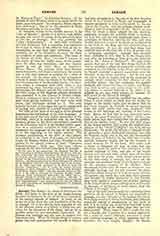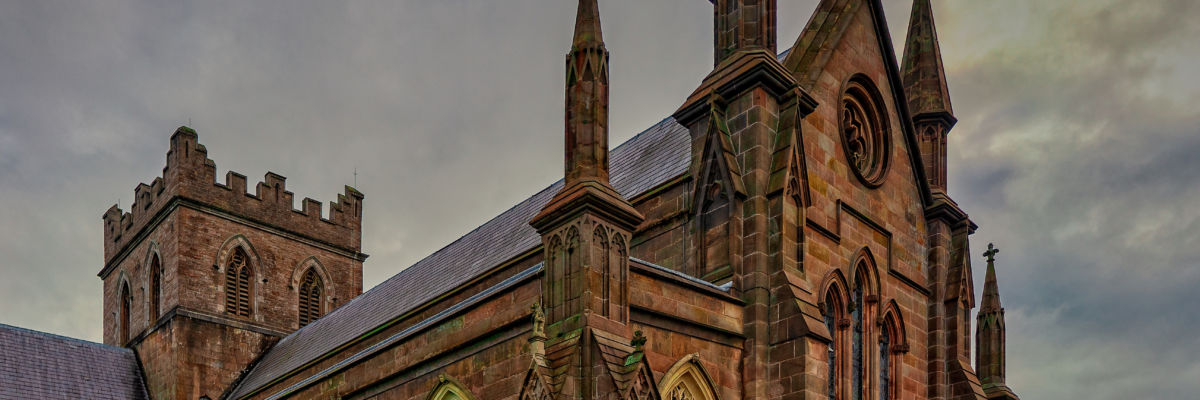

Armagh, the SCHOOL OF, seems to have been the oldest, and down to the time of the Anglo-Norman invasion continued to be one of the most celebrated, of the ancient schools of Ireland. It dates, so far as we can judge, from the very foundation of the See of Armagh, for it has always been regarded as one of the primary duties of a bishop to make due provision for the education of his clergy, and as far as possible under his own immediate supervision. St. Patrick was certainly not the man to neglect this important duty. When the foreign clergy of various grades who had accompanied the apostle to Ireland had been all assigned to the care of the first churches which he had founded in Meath and Connaught, it became necessary to train native youth for the service of the Church. For this purpose Patrick established a kind of peripatetic school. That is to say, when he found a likely subject for the ministry, especially amongst the youthful bards cr brehons, he took him into his own missionary train, wrote a catechism of Christian doctrine for him, and then handed him over to one of his clerics to be instructed in the Ordo of the Mass and the administration of the sacraments. It was the very best thing that could be done at the time, but it was, of course, only a temporary expedient. Armagh was founded most probably in 457, that is, in the twenty-fifth year after the founding of Trim as we are expressly told in the “Notes to Tirechan”. We may fairly assume that one of the very first things Patrick did was to establish a school in connection with his own cathedral, for the training of the clergy, and no doubt he himself exercised a general supervision over the direction of the infant seminary. But he was now too old to teach in person, and so his coadjutor in Armagh would naturally be chief director of the Cathedral School. His first coadjutor, his nephew Sechnall, died about this time, or earlier, and Benignus, Irish secretary and psalm-singer to the saint, was chosen to succeed Sechnall in the office of coadjutor; so, we may fairly assume, he became the first rector of the School of Armagh.
Benignus was admirably qualified for the office. There is some reason to think that his family belonged to the bardic order, and we know that he had been trained by Patrick in sacred learning from his early youth and was, moreover, well versed in the language and learning of his native land. Hence, we find that he was appointed secretary to the great Commission of Nine, which a few years before had been constituted for the purification of the Brehon Laws. He was also chief singer in the church services, and to him the original compilation of the “Book of Rights” has been always attributed. No doubt the School of Armagh would be primarily a great theological seminary, not only for Patrick’s royal city or see, but also for students from all parts of Ireland; for the chief seat of ecclesiastical authority should also be the fountain of sound doctrine for all the land. But under such a rector as Benignus we may be sure that due attention would be paid to the cultivation of the ancient language of Erin, and also of her bardic history and rornantic tales, which were all familiar to him from his youth. Still, sacred science would be the chief study of Armagh, and, above all, the constant and profound study of the Scripture would be the primary purpose of its scholars. Their theological studies were all based on Scripture, and although theology had not yet assumed the scientific form which was given to it by the great scholastic doctors, and which has ever since been retained and brought to higher perfection in the Church, they were careful to expound the positive theology of the Latin Fathers, whose writings were well known in Armagh, as we know, to some extent, from the “Book of Armagh” itself.
One of the most famous books at a somewhat later period in all the schools of Ireland and especially at Armagh, was the “Morals” of St. Gregory the Great. It is a large treatise in thirty-five books, and, although nominally merely a commentary on the Book of Job, it is in reality one of the most beautiful works on moral theology in its widest sense that has ever been penned. Every verse of Job is made the text for a homily; not a homily of a formal character, but a series of moral reflections conveyed in sweet and touching language, in which argument and exhortation are very happily blended. On Sacred Scripture St. Jerome seems to have been the best authority; and we know, both from the fragments of Aileran the Wise, published by Migne, and from the Irish manuscripts of St. Columban’s great monastery at Bobbio, that our Irish scholars were familiar with nearly all his work. In dogmatic theology we do not think that, during the first two centuries of their history, the Celtic scholars were familiar with the writings of St. Augustine on “Grace“. They seem to have derived their dogma from St. Hilary and other writers of the French Church rather than from the great Father of the African Church.
One of the earliest and most distinguished teachers of the School of Armagh, after the time of St. Patrick and St. Benignus, was Gildas the Wise. His great work, the “Destruction of Britain”, which is still extant, shows that he was a man both of large culture and of great holiness, wonderfully familiar with the text and application of Sacred Scripture, and in every way qualified to rule the Schools of Armagh. We know little or nothing of the writings of the subsequent teachers in the School of Armagh, though we have a record of the names of several, with eulogies of their wisdom and scholarship. The number of English students attracted to the Schools of Armagh by the fame of their professors was so great that in later times the city was divided into three wards, or “thirds”, as they were called: the Trian Mor, the Trian Masain, and the Trian Saxon—the last being the English quarter, in which the crowds of students from Saxonland took up their abode, and where, as we know on the express testimony of a contemporary writer, the Venerable Bede, they were received with true Irish hospitality, and were all, rich and poor, supplied gratuitously with food, books, and education. Anyone glancing at the “Annals of the Four Masters” will find frequent references made, from the sixth to the twelfth century, to the deaths of the “learned scribes”, the “professors of divinity”, the “wise doctors”, and the “moderators”, or rectors, of the School of Armagh. In 720, 727, and 749 we find recorded the deaths of three of these learned scribes within a very short period. Their duty was to devote themselves to the transcription of manuscript books in the Teachscreaptra, or “House of Writings”, corresponding to the modern library. The “Book of Armagh“, transcribed there A.D. 807, shows how patiently and lovingly they labored at the wearisome work, “as if”, says Miss Stokes, “they had concentrated all their brains in the point of the pen”. And yet, during these very centuries, the schools, the churches, and the town itself suffered terribly from the lawless men of those days, especially the Danes. Armagh was burned no less than sixteen times between the years 670 and 1179, and it was plundered nine times, mostly by Danes, during the ninth and tenth centuries. How it survived during these centuries of fire and blood is truly marvellous. In 1020, for instance, we are told by the Four Masters that “Ard-Macha was burned with all the fort, without the saving of any house in it except the House of Writings only, and many houses were burned in the Trians, and the Great Church was burned, and the belfry with its bells, and the other stone churches were also burned, and the old preaching-chair, and the chariot of the abbots, and their books in the houses of the students, with much gold, silver, and other precious things”. Yet the city and schools of St. Patrick rose again phoenix-like from their ashes. In 1100, Imar O’Hagan, the master of the great St. Malachy, was made abbot, just two years before the death of Malachy’s father, the Blessed Mugron O’More, who had been “chief lector of divinity of this School, and of all the west of Europe”
Twelve years later we have a record of the death of O’Drugan, chief professor of Ard-Macha, “paragonof wisdom of the Irish, and head of the council of the west of Europe in piety and in devotion”. Just at this time, in 1137, the great Gelasius, who well deserved his name, the Giolla Iosa, or “Servant of Jesus”, succeeded St. Malachy in the See of Armagh, and in spite of the disturbed state of the times raised the school to the zenith of its splendor. In 1162 he presided over a synod of twenty-six bishops held at Clane, in the County Kildare, in which it was enacted that no person should be allowed to teach divinity in any school in Ireland who had not, as we should now say, “graduated in the School of Armagh. To make Armagh worthy of this preeminence we find that in 1169, the very year in which the Norman adventurers first landed in Ireland, King Rory O’Conor “presented ten cows every year from himself, and from every king that should succeed him forever, to the professor of Ard-Macha, in honor of St. Patrick, to instruct the, youth of Ireland and Alba in learning”. The professor at the time was in every way worthy of this special endowment, for he was Florence O’Gorman, “head moderator of this School and of all the Schools in Ireland, a man well skilled in divinity, and deeply learned in all the sciences”. He had travelled twenty-one years in France and England and at his death, in 1174, had ruled the Schools of Armagh for twenty years. It was well for the venerable sage that he died in peace. Had he lived four years more he would have seen the sun of Armagh’s glory set in darkness and blood, when De Courcy, and De Burgo, and De Lacy, year after year, swooped down on the ancient city, plundered its shrines, and slaughtered or drove far away its students, its priests, and its professors. Once again Armagh was made desolate by ruthless bands, and that desolation was more complete and more enduring than the first. Let us hope, however, that the proud cathedral lately built on Macha’s Height gives promise of a glorious future yet in store for the ancient city of St. Patrick, and for its famous Schools.
JOHN HEALY


